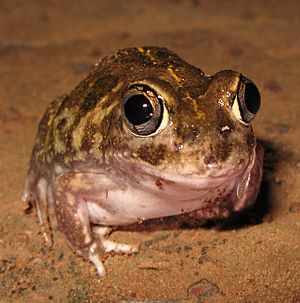Neobatrachus facts for kids
Quick facts for kids Neobatrachus |
|
|---|---|
 |
|
| Sudell's frog, Neobatrachus sudelli | |
| Scientific classification |
|
| Kingdom: | Animalia |
| Phylum: | Chordata |
| Class: | Amphibia |
| Order: | Anura |
| Family: | Limnodynastidae |
| Genus: | Neobatrachus Peters, 1863 |
| Species | |
|
See text |
|
 |
|
| The range of Neobatrachus | |
Neobatrachus is a group of special frogs that live in Australia. They are often called burrowing ground frogs because they can dig underground! You can find them in almost every part of Australia, except for Tasmania and the very northern areas, and most of Queensland. Many of these frogs live in the southwestern part of Western Australia.
These amazing frogs often live in dry places. They dig deep into the ground to stay safe from the heat and to avoid drying out. You might find them in temporary puddles or flooded grassy areas after it rains.
Contents
What do they look like?
All Neobatrachus frogs have a similar look. They are usually round and squat, with big eyes. Their pupils (the black part in the middle of their eyes) close up and down, not side to side. They have short legs, and their front feet (hands) don't have webbing, but their back feet are partly webbed. Male frogs in this group don't have a vocal sac, which is the pouch some frogs inflate to make loud calls.
How do they survive in dry places?
These burrowing frogs have special features in their genes (their DNA) that help them live in very tough environments. Most animals have two sets of genes, but some Neobatrachus species are tetraploids, meaning they have four sets of genes! This unique genetic setup helps them survive in challenging conditions.
Life Cycle and Reproduction
The way these frogs reproduce depends a lot on rain. In the dry parts of Australia where they live, rain can be hard to predict. When enough rain falls and creates temporary pools of water, the frogs quickly come out of their burrows. They gather in large numbers, and the males become very busy trying to find a female to mate with. Sometimes, several males might even climb over one female!
Female frogs lay about 1000 eggs in a long chain in the still water. The tadpoles (baby frogs) of Neobatrachus can be quite tough. If food becomes scarce or the water in the pool starts to dry up, the stronger tadpoles might eat the weaker ones to survive.
Discovery and Naming
The group of frogs known as Neobatrachus was first described by a scientist named Wilhelm Peters in 1863. Later, in 2010, a new study helped to clear up the names of several species and looked closely at a specific frog that was used to describe the Neobatrachus albipes species.
Species
| Common name | Binomial name |
|---|---|
| White-footed frog | Neobatrachus albipes Roberts, Mahony, Kendrick, and Majors, 1991 |
| Northern burrowing frog | Neobatrachus aquilonius Tyler, Davies, and Martin, 1981 |
| Tawny frog | Neobatrachus fulvus Mahony and Roberts, 1986 |
| Kunapalari frog | Neobatrachus kunapalari Mahony and Roberts, 1986 |
| Humming frog | Neobatrachus pelobatoides (Werner, 1914) |
| Painted burrowing frog | Neobatrachus pictus Peters, 1863 |
| Sudell's frog | Neobatrachus sudelli (Lamb, 1911) |
| Shoemaker frog | Neobatrachus sutor Main, 1957 |
| Goldfield's bull frog | Neobatrachus wilsmorei (Parker, 1940) |
See also
 In Spanish: Neobatrachus para niños
In Spanish: Neobatrachus para niños

